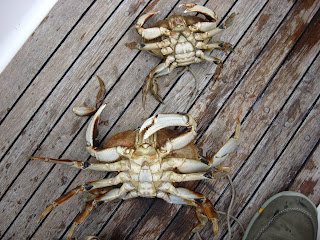 In Prince Rupert, Jan and Jim Evans join us. These are friends that go back to our Boston days in the late 70’s. We’ve skied Telluride, Alta and Val D’Isere with them, sailed the Adriatic with them and now the BC coast on Avante. They arrive in rain, but they have their jade sunny weather charms on. They work! The sun breaks out in the afternoon. Our spirits lift. Prince Rupert even takes on a certain charm. We have a last dinner in a fine restaurant overlooking the harbor. The setting sun is in our eyes. It’s so bright and so warm. Pinch me – this must be a dream!
In Prince Rupert, Jan and Jim Evans join us. These are friends that go back to our Boston days in the late 70’s. We’ve skied Telluride, Alta and Val D’Isere with them, sailed the Adriatic with them and now the BC coast on Avante. They arrive in rain, but they have their jade sunny weather charms on. They work! The sun breaks out in the afternoon. Our spirits lift. Prince Rupert even takes on a certain charm. We have a last dinner in a fine restaurant overlooking the harbor. The setting sun is in our eyes. It’s so bright and so warm. Pinch me – this must be a dream!On July 24th, we refuel and head out of Prince Rupert. The day is overcast with light winds. However, in the afternoon, the wind picks up. The Captain says it’s time to raise the sails. As we had not had an opportunity to raise sail since the last backbreaking attempt with Nelson, the Captain’s improvised system of pulley, tackle and winches is still unproven. It’s quite ingenious, not very pretty and protests menacingly with creaks and groans, but it works. The mainsail goes up. The Captain is pleased, and The First Mate and Crew are impressed. The cabin-top electric winch is not fixed, but it is by-passed effectively for now. And … the next morning, the generator overheats and stops. Fix one problem, another takes its place.
However, as we have overnighted in Crab Trap Cove per The First Mate’s trial run as daily route planner, we also have 3 nice crabs in the trap so all is not lost. Bill does necessary trouble shooting on the generator. It appears to be the raw water pump impeller. Do we have another one? Yes! Fixing the generator will be tonight’s job.
However, as we have overnighted in Crab Trap Cove per The First Mate’s trial run as daily route planner, we also have 3 nice crabs in the trap so all is not lost. Bill does necessary trouble shooting on the generator. It appears to be the raw water pump impeller. Do we have another one? Yes! Fixing the generator will be tonight’s job.
We stop for a lunch of crab and salad in a secluded little spot called Port Canaveral. We sit in the sun and enjoy th
 e warmth. It is a wonderful respite, and, little do we know it’s going to be the last of the sun we will see until the last day of this leg. So much for sun-bringing good luck charms. Well, 2 days is better than none. We continue on and anchor for the night at 8:45. It’s a late stop, but The Captain tells The First Mate that Distance Traveled is directly related to Time Needed for that Distance to be traveled. Lunch stops have a negative impact on Time Needed to make Distance Traveled. And that is the end of The First Mate’s first run as daily route planner.
e warmth. It is a wonderful respite, and, little do we know it’s going to be the last of the sun we will see until the last day of this leg. So much for sun-bringing good luck charms. Well, 2 days is better than none. We continue on and anchor for the night at 8:45. It’s a late stop, but The Captain tells The First Mate that Distance Traveled is directly related to Time Needed for that Distance to be traveled. Lunch stops have a negative impact on Time Needed to make Distance Traveled. And that is the end of The First Mate’s first run as daily route planner.Bill dives, wedges and squeezes into the generator compartment and, with Jim’s assistance, gets the thing fixed. We all hold our breath as he fires it off. It works. The impeller doesn’t implode. We’re back in business! Dinner is very late that night, but it is eaten with tired satisfaction and the knowledge that, with the generator back on line, we will have enough electricity for heat and hot water for real showers tomorrow night. Again, it’s the little things that are important on boats!
We have one big timing issue with this leg and that’s the return crossing of Queen Charlotte Strait – my one and only nemesis on this whole trip to date. We need to cross it on a somewhat benign day or at least a day without gale force or worse winds. We have a day or 2 of waiting time planned into the schedule, but we’d like to get there, get across and use those extra days to cruise around the islands across from Port Hardy before heading in to drop Jan and Jim off for their plane flight out. I, particularly, would like to return to the little floating village of Sullivan Cove. Thus, we are under a time dictate to”keep on truck’n”. Does that explain why The First Mate’s trial run as daily route planner failed? It was a beautiful, well-planned day; it just didn’t fit with the overall schedule. Oh, dear…..

There are several fronts all slowly moving around out there. It’s just a matter of time before we really get hit, but, in the meantime, the building weather and cloud cover is a show in itself.
The evening of July 26th, we motor in limited misty visibility into Helmcken Inlet. The entry in is the narrowest we have yet encountered thus far with steep, overgrown walls. Though there have been narrower, shallower underwater passages to navigate thru, this is the narrowest from a topside perspective. I’m at the helm and with the reduced visibility, I really don’t have a lot of forward view and find myself relying more on the compass and the chart on the Furuno. I am told to steer down the center of the passage, which I do believe I am doing according to my trusty instruments since every time I look up from the compass or the Furuno, all I see are close-in steep walls and the back of some masculine head. Jan is the only one who understands where her body is in relation to my view corridor. The men, one or the other or both, stand in the middle of the boat and make an effective block. The Captain cautions The First Mate again to steer down the middle, and I tell him with mild exasperation that that’s what I’m doing – steering right down the middle of the back of his head. “Oh,” he says and moves to the side only to resume the middle position seconds later as body spatial awareness dims once again. I return to the compass and the path shown on the Furuno. Both can be trusted more than the back of Bill’s head. Bill offers that he will assume the helm on the way out in the morning so I can relax and take photos. That’s fine, and I know exactly where I’m going to stand on the way out!

Once inside, we find ourselves alone in a secluded lagoon anchorage. It’s beautiful, lonely and peaceful. We go to sleep with the sound of a nearby waterfall.

The next morning is misty with fog. Bill motors us out of the bay, and I get to enjoy the views I missed on the way in. What a rare and wonderful place! The isolating mist just adds to the special aloneness of the area.

Relieved of duties, the First Mate can enjoy the views and take pictures of the Captain as he navigates the twists and turns.
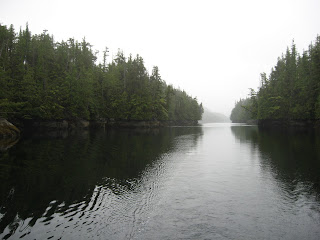
Looking back into Helmcken Inlet.
The next day we cross our northbound track again as we motor toward Green Island Anchorage We also encounter our worst weather with constant, often heavy, rains and high winds. Bill and I spend a good deal of a cold, miserable day on deck, and it’s with relief that we finally anchor at Green Island.

This apparition is me bundled in 3+ layers of fleece plus waterproof gorilla gloves and with face wrapped so that only eyes show. What you can’t see is the torrents of rain plastering the boat. Some day I’ll laugh at this, wouldn’t I?
It’s only drizzling as we anchor which after the heavy rains is almost like sunshine – at least for the soul! Once again, Green Island Anchorage i s a haven for me. Not that I care to recall my seizure of unwellness crossing Queen Charlotte Strait on the way north, it was to this very anchorage that we went to recoup that day. It still is just as pretty and welcoming. Only now with the summer cruising season well advanced, we must share it with other boats. How spoiled we quickly become! However, unlike Winnebago campgrounds, cruising boat people, for the most part, seek to honor each other’s desire for quiet and peace. So, as long as you look away from other boats or fan the camera away from them, you can still easily feel and imagine you’re alone.
s a haven for me. Not that I care to recall my seizure of unwellness crossing Queen Charlotte Strait on the way north, it was to this very anchorage that we went to recoup that day. It still is just as pretty and welcoming. Only now with the summer cruising season well advanced, we must share it with other boats. How spoiled we quickly become! However, unlike Winnebago campgrounds, cruising boat people, for the most part, seek to honor each other’s desire for quiet and peace. So, as long as you look away from other boats or fan the camera away from them, you can still easily feel and imagine you’re alone.
 s a haven for me. Not that I care to recall my seizure of unwellness crossing Queen Charlotte Strait on the way north, it was to this very anchorage that we went to recoup that day. It still is just as pretty and welcoming. Only now with the summer cruising season well advanced, we must share it with other boats. How spoiled we quickly become! However, unlike Winnebago campgrounds, cruising boat people, for the most part, seek to honor each other’s desire for quiet and peace. So, as long as you look away from other boats or fan the camera away from them, you can still easily feel and imagine you’re alone.
s a haven for me. Not that I care to recall my seizure of unwellness crossing Queen Charlotte Strait on the way north, it was to this very anchorage that we went to recoup that day. It still is just as pretty and welcoming. Only now with the summer cruising season well advanced, we must share it with other boats. How spoiled we quickly become! However, unlike Winnebago campgrounds, cruising boat people, for the most part, seek to honor each other’s desire for quiet and peace. So, as long as you look away from other boats or fan the camera away from them, you can still easily feel and imagine you’re alone.Jan brought to my attention an article of note in one of our guide books about a couple sitting out a bout of rainy weather on their boat somewhere up here in this country. The husband awoke one morning several and too many days into this waiting for the rain to stop, looked out and saw the bears, eagles, fox, deer and other sundry critters all lined up 2 by 2 preparing to board his boat. He decided the wait was getting to his head. They left in the rain that day. Well, we don't yet see those animal pairs, but it certainly would in no way be a stretch of the imagination if we did.
July 29th – this is the day we are again to cross Queen Charlotte Strait. Bill decides that an early departure is in order to beat out forecasted wind and weather as we have a good distance to cover. Jim offers to assist. First thing when I get up is to fortify myself with a drug cocktail of 2 Bonine and a NoDoze. Jan and I get breakfast going, and just as we’re serving up hot oatmeal, Zing goes the fishing line. We’ve caught a fish to add to the one we caught the day before. Ho-hum -- We are definitely “in fish” on this leg!
We are able to raise sail and tack across the strait thanks to the wind coming around nicely for us. About half way over, Bill discovers that the water maker is not working. He fiddles with it as much as he can while we’re under way, but he can’t determine what the problem is. We certainly have enough water without the water maker for the next 2 days before going into Port Hardy as planned, but that means promised showers tonight for everyone are out. The crew protests, and Bill reluctantly heads us to Port Hardy for water. We fill the water tanks and the fuel ones too while we’re at it. Bill calls the private marina, but they have no space available. None of us wants to stay at the really sad public marina and there are no good nearby anchorages. So, we about face and Bill heads 1 ½ hours across to the anchorage where we had initially planned to spend the night. Since it’s going to be another late evening, I suggest we put the time to good use and get everyone else showered on the way. We arrive in Blunden Harbor. It’s a nice sheltered anchorage, and Bill says we are staying here until we head back to Port Hardy in 2 days. While we all have drinks, Bill cleans the fish and finally gets his shower. Then we all sit down to a rather late dinner. The good news about the day is that the First Mate made it across Queen Charlotte Strait in one piece, but then with the sails up, the boat wasn’t rolling around as we had on the previous crossing. No matter – I jubilantly now know I can take on all Seven Seas! (maybe)
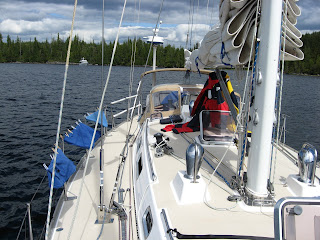 Wouldn’t you know – we wake up to sun on our last full day. We turn Avante into a floating Chinese Laundry, open up hatches, dry out the place and soak up sun. A week of rain is no fun! Bill and Jim work on the water maker. It’s finally decided that it’s another impeller imploded, but not only don’t we have a replacement, neither Bill nor Jim can determine how to get at the compartment that houses the impeller. This one is going to have to be professionally fixed with Bill watching on so that he can learn what contortionist movement is needed or what kind of arcane professional tool is required to get at the compartment where the impellor is housed. This knowledge is necessary if this ever happens on a long passage when we absolutely will need to be making water. For now, Bill and I can easily finish the remaining leg of the trip with the water in the tanks.
Wouldn’t you know – we wake up to sun on our last full day. We turn Avante into a floating Chinese Laundry, open up hatches, dry out the place and soak up sun. A week of rain is no fun! Bill and Jim work on the water maker. It’s finally decided that it’s another impeller imploded, but not only don’t we have a replacement, neither Bill nor Jim can determine how to get at the compartment that houses the impeller. This one is going to have to be professionally fixed with Bill watching on so that he can learn what contortionist movement is needed or what kind of arcane professional tool is required to get at the compartment where the impellor is housed. This knowledge is necessary if this ever happens on a long passage when we absolutely will need to be making water. For now, Bill and I can easily finish the remaining leg of the trip with the water in the tanks.

When no one comes up with any ideas for exploring, Bill finally takes the lead. We head out in The Dingbat into Bradley Lagoon. We pull ashore and hike in heavy, mossy rainforest which is surprisingly dry after all the rain. That moss really soaks it up and pulls it down deep. It’s fun walking deep in the woods on the cushiony ground cover.
July 29th – this is the day we are again to cross Queen Charlotte Strait. Bill decides that an early departure is in order to beat out forecasted wind and weather as we have a good distance to cover. Jim offers to assist. First thing when I get up is to fortify myself with a drug cocktail of 2 Bonine and a NoDoze. Jan and I get breakfast going, and just as we’re serving up hot oatmeal, Zing goes the fishing line. We’ve caught a fish to add to the one we caught the day before. Ho-hum -- We are definitely “in fish” on this leg!
We are able to raise sail and tack across the strait thanks to the wind coming around nicely for us. About half way over, Bill discovers that the water maker is not working. He fiddles with it as much as he can while we’re under way, but he can’t determine what the problem is. We certainly have enough water without the water maker for the next 2 days before going into Port Hardy as planned, but that means promised showers tonight for everyone are out. The crew protests, and Bill reluctantly heads us to Port Hardy for water. We fill the water tanks and the fuel ones too while we’re at it. Bill calls the private marina, but they have no space available. None of us wants to stay at the really sad public marina and there are no good nearby anchorages. So, we about face and Bill heads 1 ½ hours across to the anchorage where we had initially planned to spend the night. Since it’s going to be another late evening, I suggest we put the time to good use and get everyone else showered on the way. We arrive in Blunden Harbor. It’s a nice sheltered anchorage, and Bill says we are staying here until we head back to Port Hardy in 2 days. While we all have drinks, Bill cleans the fish and finally gets his shower. Then we all sit down to a rather late dinner. The good news about the day is that the First Mate made it across Queen Charlotte Strait in one piece, but then with the sails up, the boat wasn’t rolling around as we had on the previous crossing. No matter – I jubilantly now know I can take on all Seven Seas! (maybe)
 Wouldn’t you know – we wake up to sun on our last full day. We turn Avante into a floating Chinese Laundry, open up hatches, dry out the place and soak up sun. A week of rain is no fun! Bill and Jim work on the water maker. It’s finally decided that it’s another impeller imploded, but not only don’t we have a replacement, neither Bill nor Jim can determine how to get at the compartment that houses the impeller. This one is going to have to be professionally fixed with Bill watching on so that he can learn what contortionist movement is needed or what kind of arcane professional tool is required to get at the compartment where the impellor is housed. This knowledge is necessary if this ever happens on a long passage when we absolutely will need to be making water. For now, Bill and I can easily finish the remaining leg of the trip with the water in the tanks.
Wouldn’t you know – we wake up to sun on our last full day. We turn Avante into a floating Chinese Laundry, open up hatches, dry out the place and soak up sun. A week of rain is no fun! Bill and Jim work on the water maker. It’s finally decided that it’s another impeller imploded, but not only don’t we have a replacement, neither Bill nor Jim can determine how to get at the compartment that houses the impeller. This one is going to have to be professionally fixed with Bill watching on so that he can learn what contortionist movement is needed or what kind of arcane professional tool is required to get at the compartment where the impellor is housed. This knowledge is necessary if this ever happens on a long passage when we absolutely will need to be making water. For now, Bill and I can easily finish the remaining leg of the trip with the water in the tanks.
When no one comes up with any ideas for exploring, Bill finally takes the lead. We head out in The Dingbat into Bradley Lagoon. We pull ashore and hike in heavy, mossy rainforest which is surprisingly dry after all the rain. That moss really soaks it up and pulls it down deep. It’s fun walking deep in the woods on the cushiony ground cover.
Bill does a study of some tidal rapids and decides he can get The Dingbat both down them and back – so off we go. Once thru th e rapids, the waterway opens up expansively and surprisingly. We travel in about 3 miles determined to find the very beginning of this arm of water. We finally come to an end in what feels like a primeval tidal pool. There’s water rippling down, but with the heavy forest growth, it’s hard to determine exactly where it’s coming from. I wonder just how often people venture down here. It’s another one of those million miles from anywhere spots.
e rapids, the waterway opens up expansively and surprisingly. We travel in about 3 miles determined to find the very beginning of this arm of water. We finally come to an end in what feels like a primeval tidal pool. There’s water rippling down, but with the heavy forest growth, it’s hard to determine exactly where it’s coming from. I wonder just how often people venture down here. It’s another one of those million miles from anywhere spots.
 e rapids, the waterway opens up expansively and surprisingly. We travel in about 3 miles determined to find the very beginning of this arm of water. We finally come to an end in what feels like a primeval tidal pool. There’s water rippling down, but with the heavy forest growth, it’s hard to determine exactly where it’s coming from. I wonder just how often people venture down here. It’s another one of those million miles from anywhere spots.
e rapids, the waterway opens up expansively and surprisingly. We travel in about 3 miles determined to find the very beginning of this arm of water. We finally come to an end in what feels like a primeval tidal pool. There’s water rippling down, but with the heavy forest growth, it’s hard to determine exactly where it’s coming from. I wonder just how often people venture down here. It’s another one of those million miles from anywhere spots.After a relaxing, warm and sun-filled day, we sit down to our fourth night of fresh salmon from our 2 large fish. The menu for our first fresh salmon dinner was panko-crusted salmon sautéed in olive oil accompanied with homemade mayonnaise aioli sauce. That proved to be such a hit that no one wanted to try another method of preparation. Four nights in a row! All that changed was the veggies. Hey, if it ain’t broken, don’t fix it! We happily eat our last dinner together of fresh wild salmon.
July 30th is another sunny day. Two in a row! That’s a record for the last 3 weeks. We motor back across to Port Hardy hoping to be able to obtain dock space for the night, but they are still full. We do a quick reprovisioning, and then sadly say good-bye to Jan and Jim. The wind is up to 15 knots, and it’s blowing Avante hard on the dock. After an interesting disengagement of us from the dock, Bill and I eagerly set out of harbor envisioning a wonderful sail under a sparkling sun – and by the time we get to the end of the bay, the wind has died to 5 knots. Winds up here are the flukiest, strangest and most undependable. Come for the scenery, the peace and solitude – but don’t come for the sailing! Fortunately, we knew that ahead of time, but, for sailboats, it still is frustrating.
As we motor south, we hail Port McNeill for dock space. None available. Most of these places are on a first come, first served basis and we are now at the height of the season. We continue south and hail Alert Bay, a small Native Nations’ fishing village trying to make a rally as a tourist destination. To our surprise, they have room for us. We motor in, and, as we pull up to the dock they assigned us, there’s a sign that says this dock is for 40’ boats. Be that as it may, there’s room for all 52’ of Avante, and we take it with relief. Our only worry is low tide, but, according to the tide tables, we should stay floating with just about a foot below us. And, the next morning, Bill’s watching that depth gage and, sure enough, there’s just about that foot of water below our 9’ keel at low tide.
Alert Bay turns out to be a delightfully quiet, pic turesque spot, but, for us, any place where the sun is shining and it’s not rainy would be delightful and picturesque! It’s so warm; it actually feels like what we know as “summer”. We have cocktails in the evening sun and then head into town for an early dinner. We’re back on the boat, in bed by 8:30 and there’s not a peep from either of us for 12 straight hours. Captain and First Mate are utterly whipped and in need of R&R before the final leg of the trip. Though the Captain would do just fine with one day, he gives The First Mate two full wonderful, glorious days and a promise of a relaxed last leg of the trip that she gets to have her full say in. Wow! This is cruising! The only must-make date we have on our calendar is August 19th back in Telluride. That is the Wedding Celebration of Judy and Warner, our very first Crew on the very first leg of this voyage. Got to make that event for sure!
turesque spot, but, for us, any place where the sun is shining and it’s not rainy would be delightful and picturesque! It’s so warm; it actually feels like what we know as “summer”. We have cocktails in the evening sun and then head into town for an early dinner. We’re back on the boat, in bed by 8:30 and there’s not a peep from either of us for 12 straight hours. Captain and First Mate are utterly whipped and in need of R&R before the final leg of the trip. Though the Captain would do just fine with one day, he gives The First Mate two full wonderful, glorious days and a promise of a relaxed last leg of the trip that she gets to have her full say in. Wow! This is cruising! The only must-make date we have on our calendar is August 19th back in Telluride. That is the Wedding Celebration of Judy and Warner, our very first Crew on the very first leg of this voyage. Got to make that event for sure!
July 30th is another sunny day. Two in a row! That’s a record for the last 3 weeks. We motor back across to Port Hardy hoping to be able to obtain dock space for the night, but they are still full. We do a quick reprovisioning, and then sadly say good-bye to Jan and Jim. The wind is up to 15 knots, and it’s blowing Avante hard on the dock. After an interesting disengagement of us from the dock, Bill and I eagerly set out of harbor envisioning a wonderful sail under a sparkling sun – and by the time we get to the end of the bay, the wind has died to 5 knots. Winds up here are the flukiest, strangest and most undependable. Come for the scenery, the peace and solitude – but don’t come for the sailing! Fortunately, we knew that ahead of time, but, for sailboats, it still is frustrating.
As we motor south, we hail Port McNeill for dock space. None available. Most of these places are on a first come, first served basis and we are now at the height of the season. We continue south and hail Alert Bay, a small Native Nations’ fishing village trying to make a rally as a tourist destination. To our surprise, they have room for us. We motor in, and, as we pull up to the dock they assigned us, there’s a sign that says this dock is for 40’ boats. Be that as it may, there’s room for all 52’ of Avante, and we take it with relief. Our only worry is low tide, but, according to the tide tables, we should stay floating with just about a foot below us. And, the next morning, Bill’s watching that depth gage and, sure enough, there’s just about that foot of water below our 9’ keel at low tide.
Alert Bay turns out to be a delightfully quiet, pic
 turesque spot, but, for us, any place where the sun is shining and it’s not rainy would be delightful and picturesque! It’s so warm; it actually feels like what we know as “summer”. We have cocktails in the evening sun and then head into town for an early dinner. We’re back on the boat, in bed by 8:30 and there’s not a peep from either of us for 12 straight hours. Captain and First Mate are utterly whipped and in need of R&R before the final leg of the trip. Though the Captain would do just fine with one day, he gives The First Mate two full wonderful, glorious days and a promise of a relaxed last leg of the trip that she gets to have her full say in. Wow! This is cruising! The only must-make date we have on our calendar is August 19th back in Telluride. That is the Wedding Celebration of Judy and Warner, our very first Crew on the very first leg of this voyage. Got to make that event for sure!
turesque spot, but, for us, any place where the sun is shining and it’s not rainy would be delightful and picturesque! It’s so warm; it actually feels like what we know as “summer”. We have cocktails in the evening sun and then head into town for an early dinner. We’re back on the boat, in bed by 8:30 and there’s not a peep from either of us for 12 straight hours. Captain and First Mate are utterly whipped and in need of R&R before the final leg of the trip. Though the Captain would do just fine with one day, he gives The First Mate two full wonderful, glorious days and a promise of a relaxed last leg of the trip that she gets to have her full say in. Wow! This is cruising! The only must-make date we have on our calendar is August 19th back in Telluride. That is the Wedding Celebration of Judy and Warner, our very first Crew on the very first leg of this voyage. Got to make that event for sure! 


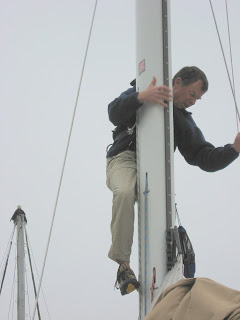



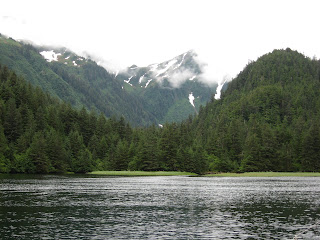

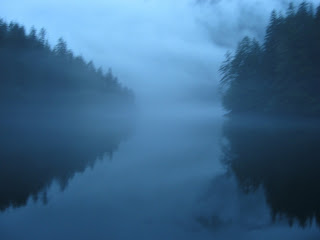

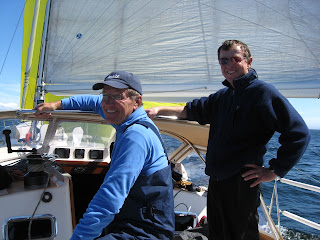
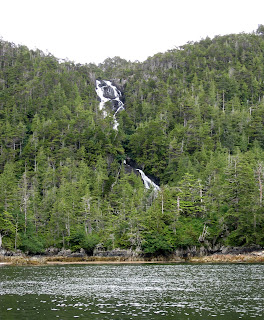

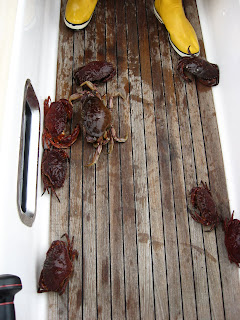

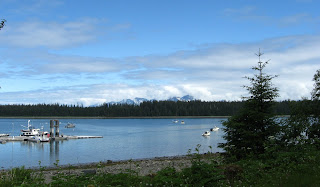

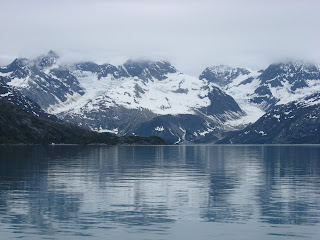


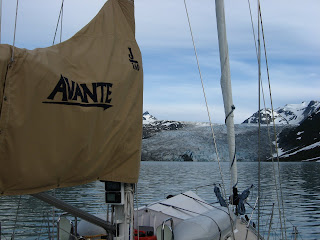









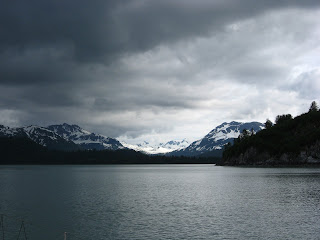
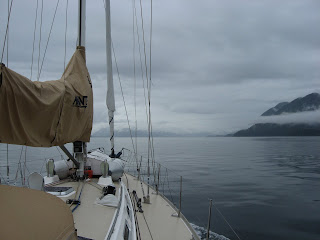

.jpg)


